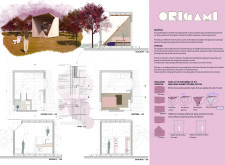5 key facts about this project
Design Philosophy and Functionality
The overall structure features a dual-level configuration that maximizes vertical space while prioritizing natural light and ventilation. The angular forms resonate with the origami theme, suggesting flexibility and transformation. Large glass panels integrate indoor and outdoor environments, facilitating energy-efficient lighting, while strategically placed overhangs provide shade and reduce heat gain. This approach enhances comfort levels in varying climatic conditions.
The choice of materials emphasizes sustainability without sacrificing durability or aesthetic appeal. The primary use of timber for the façade ensures a warm, inviting exterior that aligns with natural surroundings. Glass elements not only serve functional purposes but also contribute to a sense of openness and connection with the environment. Advanced insulation materials enhance energy performance, reinforcing the project's commitment to sustainable architecture.
Unique Design Approaches
What distinguishes Origami Haus is its thoughtful integration of architectural form with ecological design strategies. The use of cross-ventilation systems facilitates airflow throughout the interiors, contributing to efficient temperature regulation and minimizing reliance on mechanical heating or cooling. Flexible spaces are designed for multiple uses, allowing residents to adapt areas according to their specific needs, which enhances livability.
Furthermore, the structure demonstrates a clear understanding of site context. Its placement respects the existing landscape, ensuring minimal disruption to natural ecosystems. The design encourages outdoor engagement, with terraces and green spaces that promote a connection to nature while serving as extensions of the interior living environment. This duality of indoor and outdoor spaces is achieved through a coherent architectural strategy that prioritizes user experience.
Material Choices
The materials employed, including timber, glass, and insulation, reflect a commitment to sustainability and performance. Timber serves not only as a primary structural element but also as a visually appealing material that enhances the building's environmental credentials. Glass facilitates transparency and views, reinforcing the project's relationship with nature. Insulation materials, chosen for their effectiveness, contribute to the project's overall energy efficiency, further aligning with the principles of sustainable architecture.
The Origami Haus project stands as a significant example of how contemporary architectural design can harmonize with ecological considerations and user needs. To explore the intricate details, architectural plans, architectural sections, and architectural designs related to this project, readers are encouraged to review the project presentation for a more comprehensive understanding of its unique ideas and applications.























